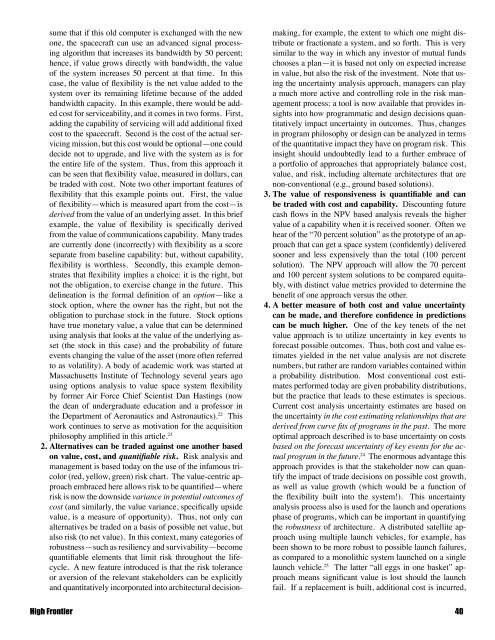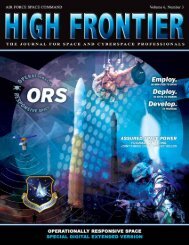Space Acquisition - Air Force Space Command
Space Acquisition - Air Force Space Command
Space Acquisition - Air Force Space Command
Create successful ePaper yourself
Turn your PDF publications into a flip-book with our unique Google optimized e-Paper software.
sume that if this old computer is exchanged with the new<br />
one, the spacecraft can use an advanced signal processing<br />
algorithm that increases its bandwidth by 50 percent;<br />
hence, if value grows directly with bandwidth, the value<br />
of the system increases 50 percent at that time. In this<br />
case, the value of flexibility is the net value added to the<br />
system over its remaining lifetime because of the added<br />
bandwidth capacity. In this example, there would be added<br />
cost for serviceability, and it comes in two forms. First,<br />
adding the capability of servicing will add additional fixed<br />
cost to the spacecraft. Second is the cost of the actual servicing<br />
mission, but this cost would be optional—one could<br />
decide not to upgrade, and live with the system as is for<br />
the entire life of the system. Thus, from this approach it<br />
can be seen that flexibility value, measured in dollars, can<br />
be traded with cost. Note two other important features of<br />
flexibility that this example points out. First, the value<br />
of flexibility—which is measured apart from the cost—is<br />
derived from the value of an underlying asset. In this brief<br />
example, the value of flexibility is specifically derived<br />
from the value of communications capability. Many trades<br />
are currently done (incorrectly) with flexibility as a score<br />
separate from baseline capability: but, without capability,<br />
flexibility is worthless. Secondly, this example demonstrates<br />
that flexibility implies a choice: it is the right, but<br />
not the obligation, to exercise change in the future. This<br />
delineation is the formal definition of an option—like a<br />
stock option, where the owner has the right, but not the<br />
obligation to purchase stock in the future. Stock options<br />
have true monetary value, a value that can be determined<br />
using analysis that looks at the value of the underlying asset<br />
(the stock in this case) and the probability of future<br />
events changing the value of the asset (more often referred<br />
to as volatility). A body of academic work was started at<br />
Massachusetts Institute of Technology several years ago<br />
using options analysis to value space system flexibility<br />
by former <strong>Air</strong> <strong>Force</strong> Chief Scientist Dan Hastings (now<br />
the dean of undergraduate education and a professor in<br />
the Department of Aeronautics and Astronautics). 22 This<br />
work continues to serve as motivation for the acquisition<br />
philosophy amplified in this article. 23<br />
2. Alternatives can be traded against one another based<br />
on value, cost, and quantifiable risk. Risk analysis and<br />
management is based today on the use of the infamous tricolor<br />
(red, yellow, green) risk chart. The value-centric approach<br />
embraced here allows risk to be quantified—where<br />
risk is now the downside variance in potential outcomes of<br />
cost (and similarly, the value variance, specifically upside<br />
value, is a measure of opportunity). Thus, not only can<br />
alternatives be traded on a basis of possible net value, but<br />
also risk (to net value). In this context, many categories of<br />
robustness—such as resiliency and survivability—become<br />
quantifiable elements that limit risk throughout the lifecycle.<br />
A new feature introduced is that the risk tolerance<br />
or aversion of the relevant stakeholders can be explicitly<br />
and quantitatively incorporated into architectural decisionmaking,<br />
for example, the extent to which one might distribute<br />
or fractionate a system, and so forth. This is very<br />
similar to the way in which any investor of mutual funds<br />
chooses a plan—it is based not only on expected increase<br />
in value, but also the risk of the investment. Note that using<br />
the uncertainty analysis approach, managers can play<br />
a much more active and controlling role in the risk management<br />
process: a tool is now available that provides insights<br />
into how programmatic and design decisions quantitatively<br />
impact uncertainty in outcomes. Thus, changes<br />
in program philosophy or design can be analyzed in terms<br />
of the quantitative impact they have on program risk. This<br />
insight should undoubtedly lead to a further embrace of<br />
a portfolio of approaches that appropriately balance cost,<br />
value, and risk, including alternate architectures that are<br />
non-conventional (e.g., ground based solutions).<br />
3. The value of responsiveness is quantifiable and can<br />
be traded with cost and capability. Discounting future<br />
cash flows in the NPV based analysis reveals the higher<br />
value of a capability when it is received sooner. Often we<br />
hear of the “70 percent solution” as the prototype of an approach<br />
that can get a space system (confidently) delivered<br />
sooner and less expensively than the total (100 percent<br />
solution). The NPV approach will allow the 70 percent<br />
and 100 percent system solutions to be compared equitably,<br />
with distinct value metrics provided to determine the<br />
benefit of one approach versus the other.<br />
4. A better measure of both cost and value uncertainty<br />
can be made, and therefore confidence in predictions<br />
can be much higher. One of the key tenets of the net<br />
value approach is to utilize uncertainty in key events to<br />
forecast possible outcomes. Thus, both cost and value estimates<br />
yielded in the net value analysis are not discrete<br />
numbers, but rather are random variables contained within<br />
a probability distribution. Most conventional cost estimates<br />
performed today are given probability distributions,<br />
but the practice that leads to these estimates is specious.<br />
Current cost analysis uncertainty estimates are based on<br />
the uncertainty in the cost estimating relationships that are<br />
derived from curve fits of programs in the past. The more<br />
optimal approach described is to base uncertainty on costs<br />
based on the forecast uncertainty of key events for the actual<br />
program in the future. 24 The enormous advantage this<br />
approach provides is that the stakeholder now can quantify<br />
the impact of trade decisions on possible cost growth,<br />
as well as value growth (which would be a function of<br />
the flexibility built into the system!). This uncertainty<br />
analysis process also is used for the launch and operations<br />
phase of programs, which can be important in quantifying<br />
the robustness of architecture. A distributed satellite approach<br />
using multiple launch vehicles, for example, has<br />
been shown to be more robust to possible launch failures,<br />
as compared to a monolithic system launched on a single<br />
launch vehicle. 25 The latter “all eggs in one basket” approach<br />
means significant value is lost should the launch<br />
fail. If a replacement is built, additional cost is incurred,<br />
High Frontier 40











